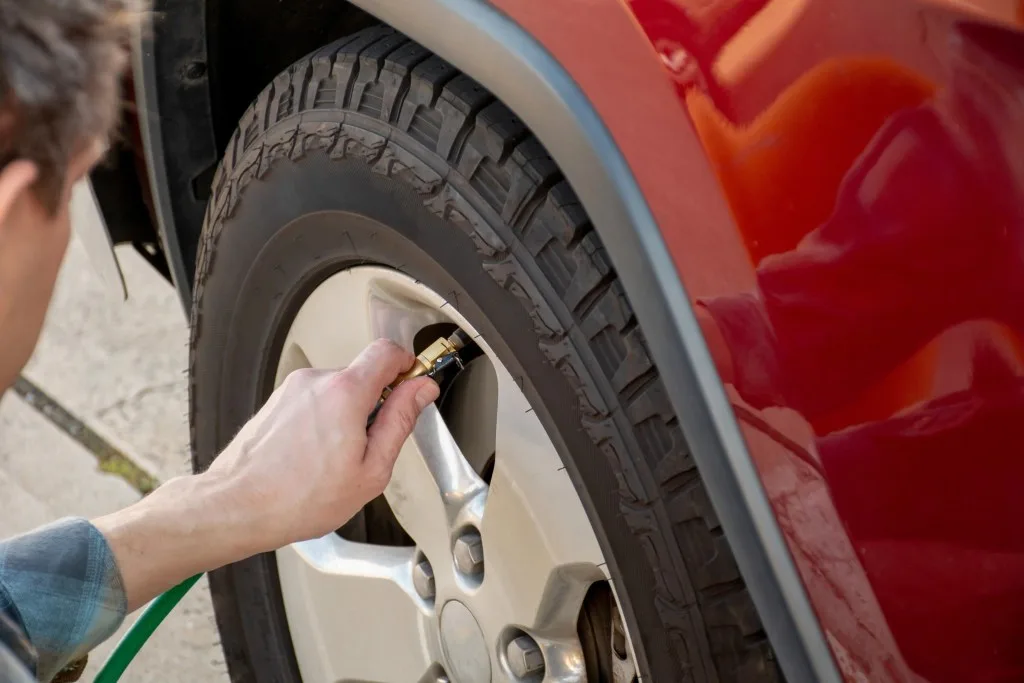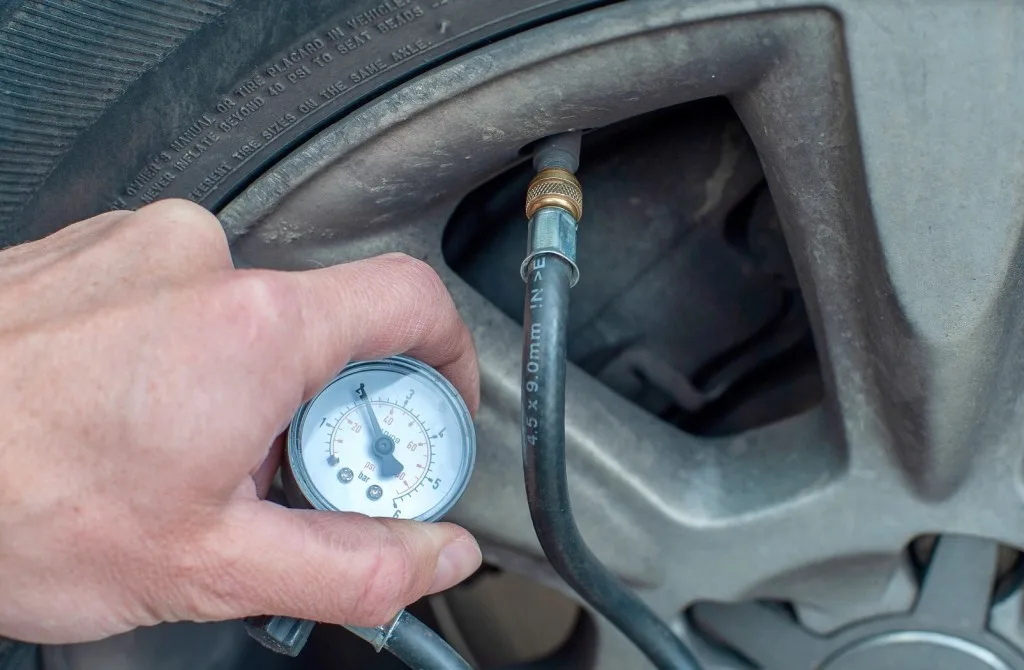Is it an emergency if you see that low tire pressure dashboard light illuminate?
Your tires are pretty important. They keep you cruising safely down the highway. It’s because of them that you can smoothly cover mile after mile.
If you take good care of them, they’re more likely to take good care of you. But, is it okay to drive with low tire pressure?
Let’s take look and see!
What Is Low Tire Pressure?
Inflatable tires require a certain amount of air pressure inside of them. When they operate under the correct pressure, it extends their life and gives the best performance. Low pressure is when the tires have lost air that it takes them out of the safe operating conditions.
Many modern vehicles have a tire pressure monitoring system (TPMS) that alerts the driver if it detects pressure outside the correct range. The driver should immediately investigate and address the situation should they receive an alert from their vehicle.

How Do I Know How Much Air Pressure My Tires Should Have?
Tire manufacturers make it incredibly easy to know how much air pressure your tires should have. They print the maximum air pressure on the side of your tires. The rating is the “maximum cold air pressure.”
This means their pressure once they’ve been able to sit in place and cool down. Your tire pressure will naturally increase as you travel down the highway.
You can also check the recommended air pressure by looking at the driver’s side door jam. Manufacturers typically place a sticker with the recommended tire size and pressure ratings. As long as you haven’t made any modifications to the size of your tires, this should give you the necessary information.
You can also check the owner’s documentation that came with your vehicle to confirm the proper air pressure for your tires. The owner’s manual will provide information directly from the manufacturer.
Pro Tip: Don’t know how to monitor your tire pressure? Discover What Is An RV Tire Pressure Monitor?
What Happens When A Tire Is Low?
When tire air pressure is low, more of your tires come in contact with the surface of the road. While this can increase traction on softer surfaces like sand and mud, it generates an incredible amount of heat when done on pavement.
As you travel down the highway with low air pressure, your tires will heat up, and the rubber and other materials will begin to break down. This not only causes premature wear and tear on your tires and shortens their life but can also lead to a dangerous blowout.

Can You Drive With Low Tire Pressure?
Will your tires roll down the highway when they’re low? Yes. Do we think it is safe or recommended? Absolutely not. If you have a single tire with low pressure, you should immediately address it. You don’t want to hit the road knowing that your tire is low; it’s a disaster waiting to happen.
You should immediately get air into your tire. If you do not have a portable air compressor or access to one, you can find spots to fill up your tires at many gas stations. This can cost $1 to $2, but it’s a small price to pay for your safety.
If all else fails, you can pull into a tire shop and have them check out your tire. They’ll likely inspect it for any leaks and fill it up to the appropriate level. Many shops offer this as a standard service for little to no cost.
How Long Can You Go With Low Pressure?
You should never drive a low tire. However, there are some circumstances where you may need to get your vehicle to an air compressor or the tire shop.
Driving at low tire pressure for an extended time or at high speeds will cause damage to your tire and potentially your vehicle. If it is an emergency, you should only go a very short distance at a low rate of speed.
Depending on the age and condition of your tires, it might not be safe to drive at all. In this situation, it’s likely safer to put on a spare tire to get you and your vehicle safely to the tire shop.
Pro Tip: Keep yourself and others safe by using these tips to avoid RV Tire Blowouts: 7 Tips to Prevent an Awful Accident.
How Do You Fix Low Tire Pressure?
If your low tire pressure light comes on, you shouldn’t immediately panic. Many cars’ warning lights come on as temperatures drop in the winter, which causes the air inside the tires to contract, and a drop in tire pressure is the result.
Simply topping off your tires with a bit of air will typically do the trick, and the light will go off a few miles down the road.
Sadly, you can’t fix all low tire issues as quickly. Your low pressure could result from picking up a nail or other sharp object in the road or a bad valve stem on your tires. If that’s the case, you’re likely going to need a trip to the tire shop.
Depending on the damage, a tire shop may patch the tire. If not, you’ll need to count your losses and replace the tire.
Why Is My Tire Pressure Low Every Morning?
A low pressure warning is common in the morning, especially during cooler temperatures. The cooler outside temperatures cause the air molecules inside your car’s tires to contract, which causes a pressure drop.
You’ll want to check all of your tires to confirm this is the issue and top them off with a little bit of air. Warning lights should disappear after traveling a few miles down the road, and the sensors reset.
How Low Can A Tire Be Before It’s Unsafe?
Your tires aren’t a game of limbo; you don’t want to see how low you can go. It’s certainly not worth putting yourself and others in a dangerous situation. A tire blowout can cause immense damage to your vehicle and has the potential to cause an accident.
If you get a notification for low tire pressure, don’t delay addressing it. Take it to a professional if you can safely do so.
Have you had a low tire pressure come on while driving? Tell us your story in the comments below!
Discover the Best Free Camping Across the USA
To be honest with you, we hate paying for camping. There are so many free campsites in America (with complete privacy).
You should give it a try!
As a matter of fact, these free campsites are yours. Every time you pay federal taxes, you’re contributing to these lands.
Become a FREE CAMPING INSIDER and join the 100,000 campers that love to score the best site!
We’ll send you the 50 Best Free Campsites in the USA (one per state). Access the list by submitting your email below: